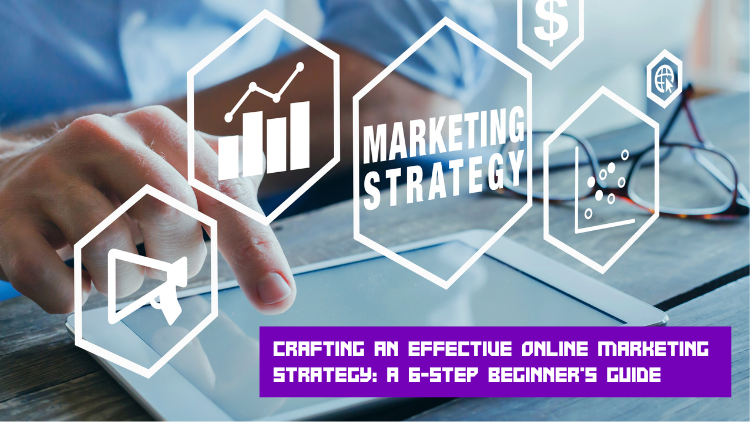In today’s fast-paced digital landscape, having a well-defined online marketing strategy is essential for any business -small or big- aiming to thrive and reach its target audience. In particular, an effective digital strategy should be customer-centric, considering both buyer personas and their journey while also being informed by data and competitor analysis.
This guide will outline a step-by-step approach to help you create a successful online marketing strategy that aligns with your business goals. We will delve into buyer personas, their journey, and competitive analysis, providing practical insights to elevate your marketing efforts!
Are you ready to upgrade your digital presence in six, easy-to-follow steps?
Step 1: Understanding Your Audience through Buyer Personas
The foundation of any marketing strategy lies in understanding your target audience. The best way to do that is to identify your buyer personas. These are non-other than fictional, yet highly detailed, representations of your ideal customers. By creating buyer personas, you gain valuable insights into their preferences, pain points, and motivations. With all of this information, you will then be able to craft a more targeted and effective online marketing strategy.

To develop your buyer personas, start by following these three steps:
- Conduct Research: Collect data through customer surveys, interviews, and social media analytics to gather information about your existing (or desired) customers’ demographics, behaviors, and preferences.
- Identify Patterns: Analyze the data to identify common characteristics and preferences among your customers. Group these findings into distinct buyer personas based on similarities. You can create more than one buyer persona based on specific products or target markets.
- Create Detailed Profiles: Give each persona a name (ideally based on its occupation or characteristics, such as “Marketing Susy” or “Tech Ben”), and create a comprehensive profile that includes details like age, occupation, challenges, interests, and goals.
If you want to simplify the process, use this free Hubspot template. Now you are ready to move to step two.
Step 2: Mapping your Buyer’s Journey
Once you have your buyer personas, the next step is to map their journey. A buyer’s journey generally consists of three main stages: awareness, consideration, and decision. Understanding this journey helps you tailor your marketing efforts to address the specific needs of your customers at each stage.
Let’s have a look at the most effective marketing tools for each stage.
- Awareness Stage: During this stage, customers identify a problem or a need. To engage them effectively, create content that educates and raises awareness about their main concerns without being overly promotional. Consider using blog posts, informative videos, and social media content.
- Consideration Stage: At this stage, customers are evaluating different solutions to their problems. Provide detailed and comparative content such as case studies, e-books, webinars, and testimonials that showcase your products or services’ value.
- Decision Stage: Finally, customers are ready to make a purchase decision. Offer incentives like discounts, free trials, or limited-time offers to entice them to choose your products or services.
Consider using this free Hubspot customer journey template to craft a more detailed marketing strategy.
Once you have understood your buyers’ behavior during these three stages, and what are the best contents to intercept their needs in each of them, it’s time to investigate your competitors’ strategies!
Step 3: Conducting a Competitive Analysis
Understanding your competition is vital to positioning your business effectively in the market. Competitive analysis helps you identify your strengths, weaknesses, opportunities, and threats in relation to your competitors and teaches you where and how you can do better than them.

To conduct a competitive analysis, you can start by:
- Identify Your Competitors: Make a list of direct and indirect competitors, including both established and emerging players in your target market.
- Analyze Their Online Presence: Study their websites, social media channels, content marketing strategies, and paid advertising campaigns to gauge their marketing approach.
- Assess Their Strengths and Weaknesses: Identify your competitors’ strengths, which you can learn from, and weaknesses, which you can leverage to differentiate your offerings.
- Explore Opportunities and Threats: Look for gaps in the market and untapped opportunities that your competitors may have overlooked. Also, be aware of potential threats that could impact your business.
Make a spreadsheet with the data you have gathered, and use it as a point of reference for the next steps!
Step 4: Developing Your Content Strategy
With a clear understanding of your audience and competitors, it’s time to craft a compelling content strategy that resonates with your buyer personas at each stage of their journey.
Here are some key points to consider:
- Tailor the Content for Each Buyer Persona: First, develop content that speaks directly to the needs and interests of each buyer persona, ensuring personalization, accuracy, and relevance.
- Utilize Various Content Formats: Experiment with blog posts, infographics, videos, podcasts, and interactive content to keep your audience engaged, and understand what works better.
- Optimize for SEO: Lastly, incorporate relevant keywords and phrases in your content to improve search engine rankings and drive organic traffic to your website.
At this point, we are almost there! All we have left to do is choose the online marketing channels that best serve your online marketing strategy, and then start actioning it!
Step 5: Choosing the Right Online Marketing Channels
To reach your target audience effectively, you must select the appropriate online marketing channels that align with your content strategy and budget.
Among the most popular channels are:
- Social Media Marketing: Engage with your audience on platforms where they spend the most time, such as Facebook, Instagram, Twitter, LinkedIn, and TikTok.
- Content Marketing: Leverage your content strategy by distributing valuable and relevant content through your blog, guest posts, and partnerships with other websites.
- Email Marketing: Nurture leads and retain customers through personalized email campaigns that offer value and incentives.
- Pay-Per-Click (PPC) Advertising: Drive targeted traffic to your website by placing ads on search engines like Google or social media platforms.
Now, it’s time to put your strategy into action and start collecting data about its performance and effectiveness.
Step 6: Analyzing and Refining Your Strategy
Once put into practice, your marketing strategy is not set in stone. It requires continuous monitoring and optimization to ensure its effectiveness. Analyze the performance of your marketing efforts using key performance indicators (KPIs) such as website traffic, conversion rates, and engagement metrics.

Based on these data, you can refine your strategy by:
- Identifying Successful Tactics: Determine which marketing channels and content types resonate most with your audience. Then, focus on maximizing their impact.
- Addressing Weaknesses: Identify areas where your strategy falls short and develop action plans to improve performance.
- Staying Agile: Be prepared to adapt to changes in the market, audience preferences, and emerging trends.
In Conclusion…
Crafting an effective online marketing strategy requires a deep understanding of your target audience, their journey, and the competitive landscape. By following the six steps outlined in this guide, you can create a well-rounded and effective marketing strategy that resonates with your audience and its needs.
As you implement and refine your strategy, always stay open to learning, evolving, and embracing innovative techniques to stay ahead in the ever-changing digital world!
If you want to learn more about the magic world of online marketing, stay tuned for the next articles in which we will delve deeper into each one of the steps outlined above. Lastly, please consider working with an online digital solution agency, such as Spacebar Sorcery, if you need personalized advice and help in crafting and actioning your online marketing strategy.
Let’s chat about your digital marketing strategy! Schedule a free consultation now!


